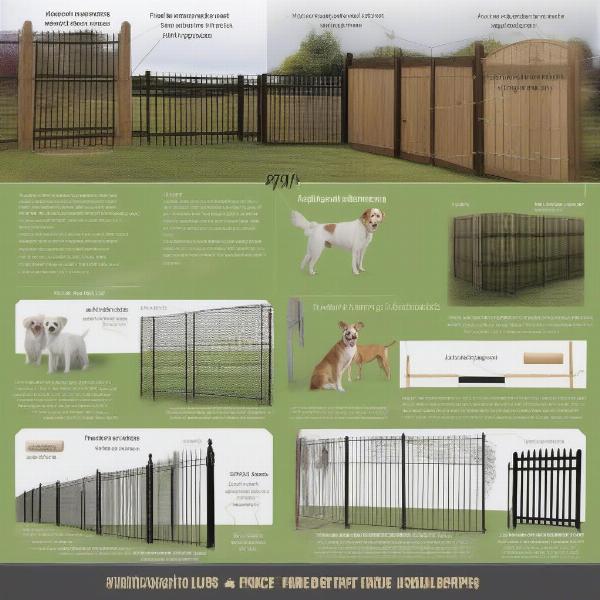A fence for your small dog is more than just a boundary; it’s a vital element for their safety and well-being. Whether you have a petite Chihuahua or a lively Jack Russell, choosing the right fence can be crucial. It provides a secure space for them to play and explore while preventing escapes and protecting them from potential dangers. This guide explores the essential aspects of choosing and installing the perfect fence for your small dog.
Factors to Consider When Choosing a Fence for Your Small Dog
Several key factors should guide your decision when selecting a fence for your small dog. Size, breed temperament, and your garden layout all play a role. A fence that’s perfect for a Great Dane won’t necessarily be suitable for a Miniature Pinscher.
Size Matters: Tailoring the Fence Height to Your Dog
The most obvious factor is your dog’s size. Small dogs can be surprisingly agile climbers and jumpers. While a short fence might seem sufficient, consider their ability to scale or squeeze through gaps. For very small breeds, a fence as low as 2-3 feet might suffice, but for slightly larger small breeds or those known for their jumping prowess, a taller fence of 4-5 feet is recommended.
Digging Escapes: Preventing Underground Adventures
Some small dogs, like terriers, are notorious diggers. If your dog enjoys excavating, a fence that extends below ground is essential. You can bury chicken wire or hardware cloth at the base of the fence to deter digging. Alternatively, consider concrete footings or paving stones around the perimeter.
Material Matters: Choosing the Right Fence Material
Various fencing materials are available, each with its pros and cons. Wooden fences are aesthetically pleasing but require regular maintenance. Vinyl fences are durable and low-maintenance, while chain-link fences are affordable and provide good visibility. Metal or composite fencing can also be suitable options. Consider your budget, aesthetic preferences, and your dog’s chewing habits when making your choice.
 Fence Options for Small Dogs
Fence Options for Small Dogs
Visibility and Interaction: Balancing Security with Socialization
While security is paramount, consider your dog’s personality. Some small dogs thrive on watching the world go by, while others may become anxious or territorial if they can see everything outside. Choose a fence that strikes a balance between security and allowing for appropriate levels of visual stimulation and social interaction.
Installation Tips for Small Dog Fences
Proper installation is crucial for the effectiveness of any dog fence. Here are some key tips:
- Secure the bottom: Prevent digging by burying wire mesh or using concrete footings.
- Eliminate gaps: Small dogs can squeeze through surprisingly small openings. Ensure there are no gaps between fence panels or at the gate.
- Gate security: A sturdy, self-closing and latching gate is essential.
- Check for hazards: Remove any potential hazards, such as sharp objects or poisonous plants, from the fenced area.
Electric and Invisible Fences for Small Dogs: A Cautious Approach
While electric and invisible fences can be an option, they are not always the best choice for small dogs. Electric fences can cause anxiety and fear, and invisible fences do not prevent other animals from entering your yard. These types of fences are best suited for larger dogs and require careful consideration and training. For containing small dogs, a physical fence is generally recommended. electric pet fence for small dogs
Keeping Your Small Dog Happy in Their Fenced Yard
Once your fence is installed, create a stimulating and enriching environment within the fenced area:
- Provide shade and shelter: Ensure your dog has access to shade and a sheltered area to escape the elements.
- Offer toys and activities: Keep your dog entertained with toys, chew bones, and interactive games.
- Create a digging pit: If your dog loves to dig, designate a specific area where digging is allowed.
Conclusion
A well-chosen and properly installed fence is a vital investment for any small dog owner. By considering your dog’s specific needs and following the tips outlined in this guide, you can create a safe, secure, and enriching environment for your small companion to thrive. small dog fence
FAQ
- What height fence is best for a small dog? It depends on the breed and their jumping ability, but typically 3-5 feet is sufficient.
- How can I prevent my small dog from digging under the fence? Bury wire mesh, use concrete footings, or place paving stones around the perimeter.
- What is the best fence material for small dogs? Wood, vinyl, chain-link, and composite are all options, each with its pros and cons.
- Are invisible fences safe for small dogs? They can be less effective and potentially cause anxiety; physical fences are generally preferred.
- What can I put in my small dog’s fenced yard? Shade, shelter, toys, and a designated digging area (if needed).
Related Articles
About ILM Dog
ILM Dog is your trusted global resource for expert dog care advice, covering breed selection, health, training, nutrition, grooming, and much more. We provide practical and reliable information for dog owners of all experience levels. Whether you’re a first-time puppy parent or a seasoned dog lover, ILM Dog offers valuable insights to help you provide the best possible care for your canine companion. For personalized advice or to learn more about our services, contact us at [email protected] or call us at +44 20-3965-8624.